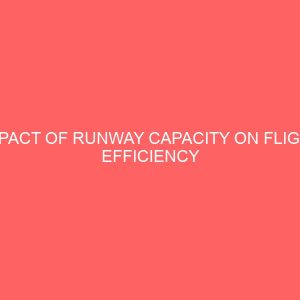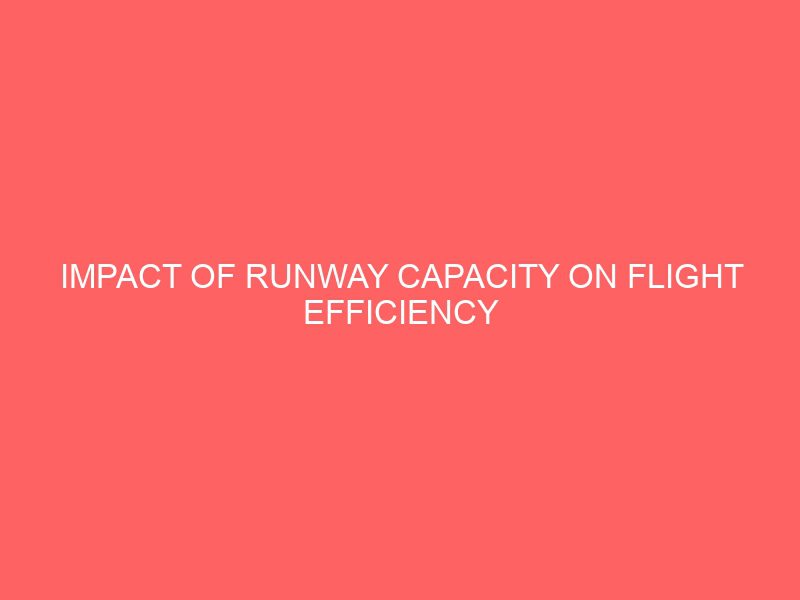Description
ABSTRACT
Congestion and delay at the airport are used in measuring the performance indicator (PI) of an airport. One key determinant of the expected activities at a given aerodrome is the airfield component and characteristic in which the runway is of great significant. According to ICAO Annex 14 which addresses Aerodrome, runway is defined as rectangular area on a land aerodrome prepared for the landing and take-off of aircraft. This research looked at the current status of runways at Murtala Muhammed airport and the role the runway plays in ensuring flight efficiency and reduction in flight delay. The instruments of data collection include; the current aerodrome chart collected from the Nigerian Airspace Management Agency (NAMA) which helped understand the various airfield component and their characteristic in the understudied aerodrome, interview were made to cover pilot and air traffic controller as the key players in flight efficiency and delay, and observations of flight activities at Murtala Muhammed airport, especially as it concern aircraft arrival and landing were made by the researcher. Based on the current layout of the Murtala Muhammed airfield and its strategic location in Lagos state, Nigeria, research question was built to consider the need to create addition runway to help facilitate flight efficiency and reduction of flight delay. This question was presented in form of a hypothetical statement and was tested. With emphasis on arrival delay which includes approach and landing of an aircraft at the understudied aerodrome, the hypotheses stipulateddefinedthe quantity of time for an aircraft to land and exit the runway which determine the runway occupancy time in other to expedite landing for other arriving aircraft. This research therefore quantified the expected delay at Murtala Muhammed airport and proffer solution to how best it can be managed. The Hypothesis were tested and the correlation between the numbers of runway presently available at Murtala Muhammed was made against the recorded delay as determined in this research.
CHAPTER ONE
INTRODUCTION
1.0 Background to the Study
Transportation is a vital activity in moving both freight and passengers around the world. It is one of the tools that civilized societies need soas to bring order out of chaos, because it cuts across every phase and facet of our existence. Air transport is relatively expensive when compared with other modes of transport likewater, road and rail system respectively.
However, air transport is the fastest of thesemodes. Aviation industry plays important role in providing for the world economies. One of the main challenges facing the aviation industry is to develop capacity to meet demand; by reducing flight delay which is one of the Key performance indicators (KPI) for aviation industry. Traffic delay is experienced whether in the departure, enrouteor arrival stage of flight operations. If an aircraft arrives late at its destination, the delayed inbound flight may not only be delayed on its next flight leg but it may also affect other flights within the airline network. Delay as defined by the oxford leaner’s dictionary is a period of time when somebody or something has to wait because of a problem that makessomething slow or late. Air traffic delay may be referred to as arrival or departure flight in excess of the estimated time on the flight plan. The root cause of delay can be either manmade or natural. The former is caused by airmen (personnel involved in flight movement) which could range from slow facilitation process, technical or maintenance problems, airspace cognition, movement breakdown while the later is caused by natural occurrence such as bad weather, natural disaster like volcano eruption, tornados. The causal effect of these factors is that goods and passengers will not get to their destination has scheduled. Apart from increasing the operational cost on the airline, it also increases fatigue on airmen, passengers etc. hence, in all ramification,` air traffic delay boilsdown to loss of resources.
Prompt performance of airlines schedule is keyfactor in maintaining satisfaction of both current and new customers in airline industry. Also,maintaining economical operations during irregular conditions is essential to achieve expected revenues. These require clever management of the different operation resources (aircraft, pilots and flight attendants) to ensure their on-time readiness for each flight in the planned schedule. However, flight schedules’ are often subjected to numerous sources of irregularity. According to Rosenberger, Schaefer, Goldsman, Johnson, Kleywegt and Nemhauser, weather accounts for nearly 75% of system delays. In an air traffic flow management (ATFM) initiative for each controlled flight, a controlled time of arrival or arrival slot is assigned at the regulated area or arrival airport. Therefore, it is good to note that ATFM approach introduces a controlled flight system as a way to manage flight delays through proper sequencing of flight strip.
Based on filed flight plans and weather forecasts, trip times (total time it takes a flight to move from origin airport to destination airport) can be estimatedwith reasonable accuracy and consequently, the controlled time of departure (CTD) at the origin airport. Thus, the control time of departure (CTD) is equal to the control time of arrival (CTA) minus the trip time, and the total delay assigned (D) is the control time of departure (CTD) minus the estimated (scheduled) time of departure (ETD).
Various studies made on airport congestion have identified several factors which generate flight delays. Such factors include;
Saturation of airport capacity (includingair transportation control activities), airline problems, reactionary delays, passengers and cargo, weather and other unpredictable disruptions (e.g. strikes). Among all these factors, delay time experienced by flights and passengers can be mostly attributed to problems caused by airtraffic control, airports infrastructure, and airlineoperations. In addition stormy weather causes delays not only at airports experiencing the inclement weather, but also at airports with flights connecting from the airports experiencing inclement weather. During stormy weather, airport capacity is reduced due to increased aircraft separations. Because of this weather condition, instrument landing systems (ILS) are required for aircraft navigation in these conditions, this situation is called Instrument Meteorological Conditions (IMC).In a Clear weather, this condition is known as Visual Meteorological Conditions (VMC).Furthermore, studies have identified the stages of flight in which delays occur and the causalfactors that result in delays. In a research conducted by Mueller the data shows that 84% of all delays occur on the ground (gate, taxi-out, taxi-in), out of which 76% are prior to takeoff (gate, taxi-out), suggesting that focusing on ground delay prediction will have the most impact on improving forecasting algorithms.Air traffic delay has become a major problem for air traveler and airline operators. Occasional delays are part of air travel today, as much as we dislike delays; we cannot avoid them even in well run airlines. Murtala Muhammed international Airport encounters the highest amount of traffic movement in Nigeria. Recently, there have been series of reports related to delays in air traffic at Murtala Muhammed airport. This delay often results in the increase in fuel consumption of aircrafts, affects passengers getting to their destination on time. In most cases the connecting flight is missed and the airline operators have no other option order than to take their passengers back to their point of departure and the ticket fair refunded back to them. Airtraffic delay cannot be averted but can be managed. Arising from the above scenario, this, study attempts to examine the relationship between airport delay and airport capacity and how best this relationship can be managed.
1.2 Statement of Problem
Apart from the direct costs imposed on the airline industry and its customers, flight delays have indirect effects on the national economy. Specifically, the role it plays toward inefficiency in the air transportation sector therefore increases the cost of doing business for other sectors, making the associated businesses less productive.
There are vase records of flight delays at many commercial airports all over the world. At Sao Paolo’s Guarulhos and Congonhas International Airports only 41% and 43% of all flights, respectively, left on time, making them the third and fourth worst cities for departures. Sao Paolo is also one of the worst places in the world for arrivals. Just 54% of the flights at Congonhas and 59% of the flights at Guarulhos arrived as scheduled.
Brazil, of course, isn’t the only country with a poor track record for flight delays. At Beijing Capital International Airport just 33% of its flights took off on time in 2007, putting it just behind Brasilia on list of worst departure airports. Egypt’s Cairo International, Africa’s second busiest airport behind Johannesburg, only saw 47% of its flights take off most time with the average wait of 43 minutes. And at sprawling Charles de Gaulle Airport in Paris–the worst place in Europe to catch a timely flight–barely 50% of its commercial passenger planes left as scheduled.
Airport authorities typically use arrival times when tracking late flights, which are considered delayed if they reach their destination at least 15 minutes behind schedule. According to conventional wisdom, pilots can make up for lost time on the ground a concept referred to as Ground holding program which is one of the basic methods of lowering the cost problem that usually occur during delay and congestion incur due to uncertainty of future landing capacity It means to have a flight wait on the ground at its point of origin than to have it circle the airport at its destination, unable to land once they’re in the air. But travelers find few things more frustrating than having to wait more than necessary at their gate or on the runway. So therefore we can have delay at departure, arrival and enroute as components of flight delay.
In the U.S., New York City has become synonymous with delayed flights as commercial and corporate jets crowd limited airspace over the city. With just 58% of its flights arriving on time in 2007, LaGuardia airport beat out Newark International (slightly more than 58% arrived as scheduled) for the worst airport in the U.S. for arrivals. They round out the top five of the world’s worst airports for delayed arrivals. Incidentally, John F. Kennedy International–New York’s largest airport with 44 million passengers annually–was barely behind them, with more than 40% of its flights arriving late.
Robert Poole, founder of the Reason Foundation and a frequent adviser to the U.S. government on transportation issues, says that, in New York, airlines have caused the delay problem by substituting smaller planes for larger ones. At John F. Kennedy International, the number of planes with less than 100 seats has grown by 128% during the last 5 years.
In this research we are looking at the Arrival delay based on available aerodrome infrastructure presently at Murtala Muhammed airport. with the following questions in mind; if an aircraft departing from origin aerodrome as scheduled why should there be Arrival delay at the destination airport? How can this delay be best managed?
1.3 Aim and Objectives
The Aim of this project is to study the currently available airport infrastructures, there effects on flight Arrival delay at Murtala Muhammed airport and to proffer solution to best manage this Arrival delays.
The objectives of this research is as follows
1. To study the available airport infrastructure in Murtala Muhammed airport.
2. To relate these available airport infrastructure to arrival delay by creating and testing hypothetical statements (hypotheses).
3. Proffer possible solution to the Arrivaldelay at Murtala Muhammed airport.
1.4 Research Questions
1. Does the number of runway determines the flight efficiency and or the delay at Murtala Muhammed airport?
2. Does the cumulative runway occupancy time directly responsible for arrival delay at Murtala Muhammed airport?
1.4 Research Hypotheses
Consequently, the following hypotheses were postulated:
1. The number of runway determines the flight efficiency and delay at Murtala Muhammed airport.
2. The cumulative runway occupancy time is directly responsible for the arrival delay at Murtala Muhammed airport
1.5 Scope of the Study
The study area is the Nigerian Airspace which is referred to as Kano Flight Information Region (Kano FIR) according to International Civil Aviation Organization (ICAO). The aerodrome of study is Murtala Mohammed International Airport located at Ikejain Lagos state. It is also important to note that the Nigerian Airspace is divided into two sectors by international civil aviation organization(ICAO) which are the Northern and Southern sector. Lagos airport (Murtala Mohammed airport) takes over the jurisdiction of all aerodromes in the Southern sector, while Kano airport (Aminu Kano International airport) takes control of all aerodromes in the Northern sector. Below is a pictorial representation of Nigerian Airspace (Kano FIR) as published by Nigerian Airspace Management Agency (NAMA).
Figure 1.1: Kano FIR enroute chart.
1.6 Study Area
1.6.1 Murtala Muhammed Airport (MMIA).
Murtala Muhammed International Airport is an International airport located in Ikeja, Lagos State, Nigeria. It was originally known as Lagos International Airport and was renamed in the mid 1970s during the construction of the new international terminal, after the former Nigerian military head of state, General Murtala Muhammed. The Murtala Muhammed International terminal was modeled after Amsterdam Airport. This new terminal was opened officially on the 15th March, 1979. It is the main base for Nigeria’s flag carrier airlines such as Aero Contractor and Arik Airline.
Figure 1.2: Photograph of Murtala Muhammed Airport, Ikeja.
Murtala Muhammed Airport consists of an international and a Domestic terminal, located about one kilometer from each other. Both terminals share the same runways. The International operations moved to the new international airport when it was ready while domestic operations moved to the Ikeja airport, which became the domestic airport. the domestic operations were relocated to the old Lagos domestic terminal in 2000 after a fire outbreak. a new domestic privately funded terminal known as MMA2 has been constructed and was commissioned on 7th April 2007.
The airfield parameter of Murtala Muhammed aerodrome consist the runway and the taxiway. The runway is designated as 18R/36L which is for the runway on the International wing of the airport. On the local wing of the airport is the runway 18L/36R. The runway at the international terminal has a parallel taxiway attached to it while the runway at the local terminal has two parallel taxiways east and west of the runway. There is also an interconnection taxiway which links both the runways at the local terminal and the runway at the international terminal together. These taxiways are designated as western (A), central (B) , interconnected (F) and eastern taxiway (C) with their assigned alphabet as signage.
Each parallel taxiway has links to the runway. for the eastern taxiway to the local runway, a total number of seven links are available to the runway. each runway is dual designated (18R/36L); this means that a single landing strip can be landed into through the two ends of the runway.
Figure 1.3: Map of Ikeja showing Murtala Muhammed Airfields
1.6.2 Runway
According to ICAO Anne 14, runway is defined as a defined rectangular area on a land aerodrome prepared for the landing and take-off of aircraft
There are two type of runway base on the available navigational aids
1. precision approach runway
2. non-precision approach runway
Precision approach runway is defined based on the presence of instrument landing system (ILS) coupled with very high frequency omini-directional radio range and distance measuring equipment (VOR/DME) navigational aids to help facilitate safe landing at the particular aerodrome.
Non- precision approach runway on the other hand isbased on the usage of very high frequency omini-directional radio range and distance measuringequipment (VOR/DME) or locator for safe landing at the particular aerodrome.
The importance of ILSis to facilitate landing even in Instrument Meteorological Condition (IMC) where the viability at the aerodrome is very poor. ILSconsists of both the Glide path and the Localizer. Together they give an aircraft an angular measurement in order for the aircraft to touch down safely on a runway even in a very bad visibility condition.
Both the international runway and the local runway at Murtala Muhammed airport are equipped withILS making the runway to belong to a precision approach runway category.
A runwayconsists of two runway directions. In MMIA the local runway has 18R and 36L, therefore giving the runway designation as 18R/36L. The international runway hasalso 18L and 36R, therefore giving the runway designation as 18L/36R.
Table 1.1 Murtala Muhammed Runway characteristics
RUNWAY
LENGTH
WIDTH
STRENGTH
SURFACE TYPE
18R/36L
2 745
45
PCN 91/F/B/W/T
asphalt







